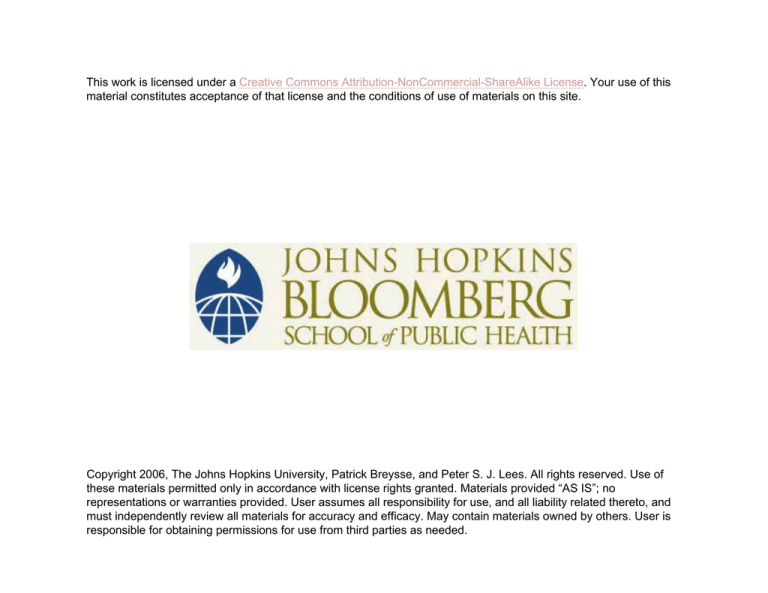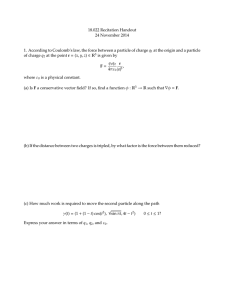
This work is licensed under a Creative Commons Attribution-NonCommercial-ShareAlike License. Your use of this
material constitutes acceptance of that license and the conditions of use of materials on this site.
Copyright 2006, The Johns Hopkins University, Patrick Breysse, and Peter S. J. Lees. All rights reserved. Use of
these materials permitted only in accordance with license rights granted. Materials provided “AS IS”; no
representations or warranties provided. User assumes all responsibility for use, and all liability related thereto, and
must independently review all materials for accuracy and efficacy. May contain materials owned by others. User is
responsible for obtaining permissions for use from third parties as needed.
Particulate Matter
Patrick N. Breysse, PhD, CIH
Peter S.J. Lees, PhD, CIH
Johns Hopkins University
Section A
Introduction and Definitions
Aerosols: Definition
Stable suspensions of solid or liquid
particles in air
Examples:
– Cigarette smoke
– Welding fume
– Sea mist
4
Types of Particulate Aerosols:
Dusts
Solid aerosols generated by the
handling, grinding, abrasion, or cutting
of a bulk material
Dust particle size is related to the
amount of energy involved in creation;
the higher the energy—the smaller the
particle created; the lower the energy—
the larger the particle created
Examples: Saw dust, coal dust
5
Types of Particulate Aerosols:
Mists
Liquid aerosols generated by
condensation from a gaseous state or
by the breaking up of a bulk liquid into a
dispersed state
Droplet size related to energy input as
in dusts and fibers
Examples: Metal working fluid from
lathe, paint spray, liquid mixing
operations
6
Types of Particulate Aerosols:
Smoke
Solid aerosols resulting from the
incomplete combustion of carbonaceous
materials
Wide range of particle sizes
Size related to combustion efficiency
– High efficiency = smaller particles
– Low efficiency = larger particles
Examples: Wood smoke, diesel exhaust
7
Types of Particulate Aerosols:
Fumes
Solid aerosols generated by the
condensation of vapors or gases from
combustion or other high temperature
processes
Usually very small and spherical
– Sources: Welding, foundry and
smelting operations, hot cutting or
burning operations
8
Types of Particulate Aerosols:
Bioaerosols
Solid or liquid aerosols from biological
sources
May be infectious, allergenic, and/or
irritating
Wide range of particle sizes
– Virus (0.002–0.03 um)
– Tree pollen (10–100um)
Examples: Mold spores, animal
allergens, anthrax
9
Types of Particulate Aerosols:
Fibers
A special (based on toxicological
properties) kind of dust that is fibrous in
nature (i.e., longer than it is wide)
Aspect ratio (L:W) defined as 3:1 or 5:1
Toxicity a function of composition, size,
and number of fibers
Examples: Asbestos, fiberglass,
refractory ceramic fibers
10
Quantification of Aerosols
mass of contaminan t
Concentrat ion =
volume of air
Typical Units: mg/m3, ug/m3
Special Units: f/cm3, cfu/m3, mppcf
11
Section B
Particle Size
Behavior of Aerosols
Airborne behavior,
such as settling
velocity, is a
function of:
Size
Specific gravity
Shape
Surface properties
Slip factor
Fluid drag forces
Buoyant forces
Particle
Gravity
13
Aerodynamic Equivalent
Diameter
The Aerodynamic Equivalent Diameter
(AED) of a particle is the diameter of a
unit density sphere that would have the
identical settling velocity as the particle
Continued
14
Aerodynamic Equivalent
Diameter
Measure of behavior of particle in air
Function of particle diameter, density,
shape, and surface characteristics
Determines site of deposition in lung
Effects air sampling characteristics
Referenced to spherical drop of water
with identical settling velocity
Continued
15
Aerodynamic Equivalent
Diameter
16
Section C
Particle Size Distributions
Particle Size Distributions
Particle sizes
of an aerosol
are typically
log-normally
distributed
Source: U.S. Government
Continued
18
Particle Size Distributions
Log
transformation of
particle size
distribution is
normally
distributed
Source: U.S. Government
Continued
19
Particle Size Distributions
Normalized size
distribution plotted
as cumulative
size distribution
Source: U.S. Government
Continued
20
Section D
Particles and Disease
Cytotoxic Dusts
Direct effect on the lungs
Examples
– Silica—Silicosis
– Asbestos—Asbestosis
– Coal Dust—Coal workers
pneumoconiosis
– Beryllium—Berylliosis and chronic
beryllium disease
Continued
22
Cytotoxic Dusts
Knowing how much and where a dust
will deposit in the lungs is important for
risk determination
23
Aerosols and Disease
Disease potential is a function of:
– Chemical properties of particle
– Site of particle deposition in
respiratory system
• Head region
• Thoracic region
• Respiratory region
– Particle clearance path/destination
24
Regional Particle Deposition
25
Site of Particle Deposition
26
Inspirable/Inhalable Dust
Definition
27
Thoracic Dust Definition
28
Respirable Dust Definition
29
Old Particle-Size Conventions
Non-respirable fraction (>10 µm AED)
– Can be breathed into nose or mouth,
penetrate head airways, and enter
lung airways
Respirable fraction (<10 µm AED)
– Can penetrate beyond terminal
bronchioles to gas exchange region
30
New Particle-Size Conventions
Inhalable fraction (<100 µm AED)
– Can be breathed into nose or mouth
Thoracic fraction (<25 µm AED)
– Can penetrate head airways and
enter lung airways
Respirable fraction (<10 µm AED)
– Can penetrate beyond terminal
bronchioles to gas exchange region
Continued
31
New Particle-Size Conventions
Outdoor or Ambient Air Pollution
Recommended by EPA
– Particulate matter <10 um (PM 10)
– Particulate matter <2.5 um (PM 2.5)
Not deposition-based
Roughly correspond to inhalable and
respirable dust
32
Section E
Mechanisms of Particle Deposition
Mechanisms of Particle
Deposition in the Lung
Inertial impactions
– Function of particle velocity and
mass
Interception
– Function of particle diameter
Continued
34
Mechanisms of Particle
Deposition in the Lung
Sedimentation (gravitational settling)
– Function of particle velocity
(residence time) and mass
Diffusion
– Function of particle diameter,
concentration, velocity (time), and
distance
Continued
35
Mechanisms of Particle
Deposition in Lung
Inertial impaction:
The process whereby a
particle moving in a gas
stream is unable to remain in
the streamline when the gas
changes direction (turns). As
a result, the particle strikes a
stationary obstacle (e.g.,
surface in respiratory system)
directly in its path and is
removed from the air.
Animated version at http://www.mfg.mtu.edu/cyberman/environment/air/depos.html
Continued
36
Mechanisms of Particle
Deposition in Lung
Interception:
The process whereby a
particle moving in a gas
stream remains in that
airstream but, because of its
dimensions, strikes a
stationary obstacle (e.g.,
surface in respiratory
system) and is removed from
the air.
Animated version at http://www.mfg.mtu.edu/cyberman/environment/air/depos.html
37
Mechanisms of Particle
Deposition in Lung
Sedimentation (gravitational settling):
The process by which a
particle in an airstream is
pulled downward by gravity
until it strikes a stationary
obstacle (e.g. surface in
respiratory system) and is
removed from the air.
Animated version at http://www.mfg.mtu.edu/cyberman/environment/air/depos.html
38
Mechanisms of Particle
Deposition in Lung
Diffusion:
The process by which the
molecules of two or more
substances (very small particles
having some molecular
characteristics) gradually mix as
a result of random thermal
motion, will strike a stationary
obstacle (e.g., surface in
respiratory system) and be
removed from the air.
Animated version at http://www.mfg.mtu.edu/cyberman/environment/air/depos.html
39








